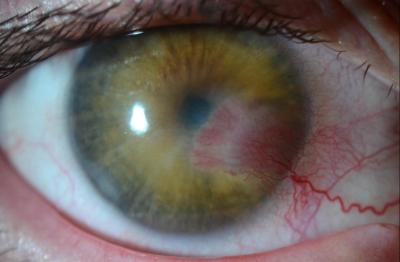Susmit Suvas, Ph,D, and collaborators at Wayne State University School of Medicine have unlocked a potential mechanism to protect against herpes stromal keratitis (HSK), a debilitating condition that occurs in response to a herpes infection in the eye.

Eye with herpes stromal keratitis. Credit Jia Yin, Harvard Medical School.
The goal of the research is to find new prophylactic and therapeutic approaches to manage the development of HSK, a major cause of infection-induced vision impairment in the United States.
“For long time, it was unclear why some eyes that shed infectious HSV-1 (herpes simplex virus) at the ocular surface do not develop herpes stromal keratitis, whereas the other infected eyes develop HSK. Our study for the first time showed that HSV-1 infected corneas that do not develop HSK exhibit a large pool of protective tissue-resident memory T cells, or Trm, whereas the corneas that develop HSK have poor quantity and quality of tissue-resident memory T cells,” Suvas said.
“The function of tissue-resident memory T cells is to clear the infectious virus before it can initiate tissue damage. Having a good quantity and quality of Trm cells in HSV-1 infected cornea protect them from the development of HSK," he said.
The studies were performed over a period of two years, as the experiments required the establishment of memory T cells in HSV-1-infected corneas. Two major outcomes of corneal HSV-1 infection are the development of herpes epithelial keratitis and herpes stromal keratitis.
“HEK is a self-resolving condition, whereas the development of HSK can cause vision loss. Our study [in mice] showed that strategies to augment the quantity and quality of tissue-resident memory T cells in HSV-1 infected corneas can reduce the incidence of the development of HSK," Suvas said.